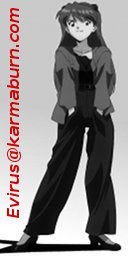|
|
Blog Archives:
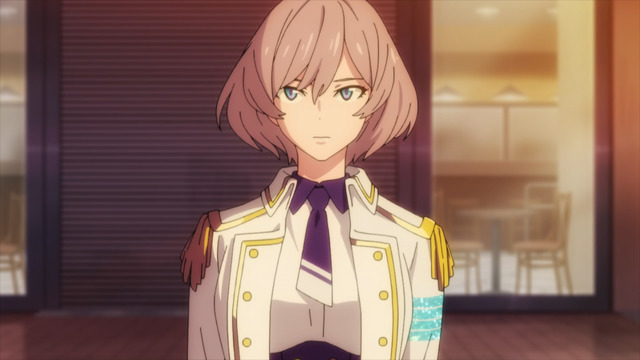
This is a picture of Mujina that doesn't show her thighs.
First off, SSSS.DYNAZENON is excellent. After this show and SSSS.GRIDMAN, I feel like Studio Trigger has finally figured out how to convey the sort of interpersonal tension and emotional baggage that they were trying to get right in Kiznaiver. As you may have surmised, the kaiju monster v. robot battles in SSSS.DYNAZENON are sort of incidental to the show's success. I mean, they're entertaining, but the series really is about the characters.
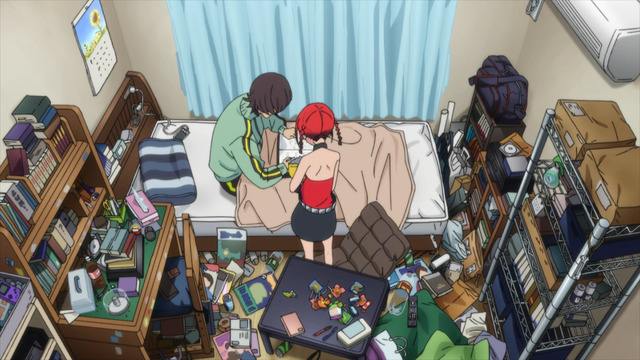
Both of them get their shit together. P.S. Spoilers.
If there's a weak spot, it's that I never cared that much about Yomogi. He's fine, but Koyomi (the NEET) had a much more interesting character arc. The bait & switch SSSS.GRIDMAN pulled with its leads was critical to its success, and I was sort of hoping SSSS.DYNAZENON would do something similar, but it worked out anyway. I don't know what this next thing is going to be, but I am looking forward to more.

I like it when they show the hidden eye of hidden-eye characters.
As I said recently, Back Arrow is bullshit. Appropriately, its ending is also bullshit, and none of that matters because I wouldn't have it any other way. Do the end-of-series reveals make any sense? Enough so, I guess. Do I wish they seemed more sensible? Not at all. How much you enjoy this show very much depends on your expectations for it. Ideally, you should expect scenery to get chewed. And how.

I came here to sing songs and kick ass, and I'm all out of songs. (Well, except one.)
Based on reactions I saw on the Twitter and elsewhere, reactions to the ending of Vivy -Fluorite Eye’s Song- are generally negative. I think most of the dissatisfaction has to do with logical inconsistencies, lazy storytelling, and not making any damn sense. Basically every criticism I've seen has been valid, although I'm considerably more positive about the show overall than its detractors. Potentially, this has to do with expectations and me setting a pretty low narrative hurdle for Vivy to clear. Possibly, I just have a soft spot for singing robots the way Jenny Nicholson has a soft spot for animatronics.

Extremely loose birth control glasses is somebody's fetish.
Godzilla Singular Point also recently ended. Y'know, there was a lot less Godzilla in a show about Godzilla than I was expecting. Unfortunately, what the show was mostly about was barely comprehensible technobabble. It had some neat ideas, but I'm not really sure a Godzilla anime was the right vehicle for it. Really, they could have just done that story on its own, separately, without involving Godzilla at all. (And they almost sort of did.) The other part of Singular Point, though, with the dudes and their extremely Kugimiya Rie robot, was a lot more fun, even if none of those characters wore birth control glasses.

Lucky for Mei, her extremely loose birth control glasses stay on when she runs.
I still enjoyed Godzilla Singular Point overall, but I don't know that I would recommend it to anyone who isn't obsessed with grad students who always dress like it's laundry day. For that matter, SSSS.DYNAZENON is probably the only one of these four that I would recommend without qualification. Back Arrow, I can recommend to people who enjoy bullshit and fucked-up bangs. Vivy -Fluorite Eye’s Song-, I can recommend to people with fond memories of Chuck E. Cheese. Also, robosexuals.
Posted in Back Arrow, Godzilla, Godzilla Singular Point, RECOMMENDATIONS, SSSS.DYNAZENON, Vivy -Fluorite Eye’s Song | Tags: Androids, Giant Robots, Hair, Koshimizu Ami, Kugimiya Rie, Mecha, Minmay Attack, Season Conclusion, Spring 2021, Studio Trigger | Permanent Link
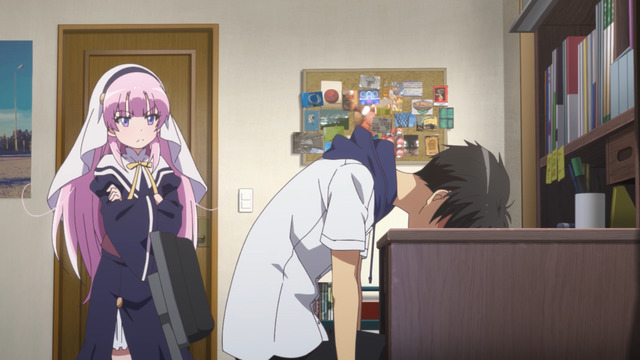
I had to include a picture of these two because they're the main characters.
Despite a promising first episode, Kamisama ni Natta Hi (The Day I Became a God) turned out to be fairly awful in a number of areas, and likely disappointed even fans of Key's usual shtick. Critically, I felt nothing when The Big Sad Thing inevitably happened. This despite reports Maeda Jun intended for it to be the saddest anime ever. Surprising no one, I'm sure, Hina suffers debilitating mental degradation just as Potato-kun comes to realize how important she has become to him. Unfortunately, the way he conveys his emotions and the actions he takes for pretty much the entire rest of the anime are aggravating to watch. It's sort of baffling, even if you're already expecting this to happen to some degree.

For real, though, Kyouko had excellent hair.
Ultimately, it's entirely unrewarding. I can see how at least in theory Kamisama ni Natta Hi looked like it could succeed when viewed as an outline or synopsis (you know, assuming you're okay with infantalizing love interests), but it certainly fell apart somewhere between the initial pitch and the screen. It's not all bad, though. I genuinely enjoyed the mostly standalone episode where Violet Evergarden and her father come to grips with Dead Mom Subplot. That basically had all the, uh, Key elements of Maeda Jun's bullshit done right. And I liked the Mahjong Calvinball episode which had the sort of high-energy wackiness I remember from the Angel Beats! fishing episode. The Day I Became a God did continue to have some nice gags throughout its run, although the first episode probably had the most successful jokes. I'm still willing to watch the next Key anime, but I get the feeling I'll enjoy it a lot more if its a sports comedy of some sort instead of another romance involving mentally impaired girls.
Posted in Kamisama ni Natta hi | Tags: Autumn 2020, Bad Things Happen to Good People, Hair, Infantilization, Jun Maeda, Key, Moe Blobs, P.A. Works, Romance, Sad Girls in Snow, Season Conclusion, Spoilers, Superlovely Character Designs, Unrequited Love | Permanent Link
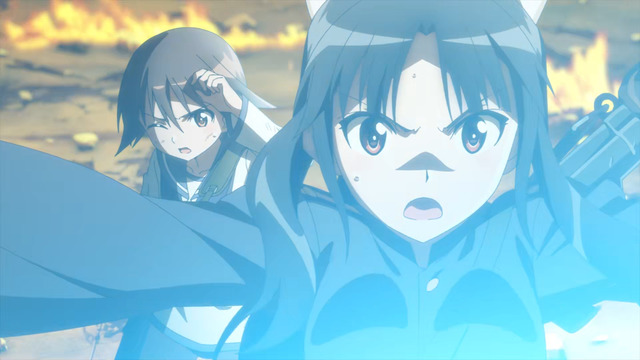
I don't dislike Miyafuji anymore, but these two still aren't exactly favorites.
It's been a while since I've watched the first two Strike Witches seasons, but I felt this third season seemed better overall than those previous installments. I also liked it better than the Brave Witches spinoff. Despite this, I'm still not at all prepared to call Strike Witches: Road to Berlin the best season yet even though it sort of has to be by definition. The problem is Road to Berlin still relied on the Neuroi as the primary advesary. This is an unavoidable component of the World Witches canon, but these alien invaders have never been compelling enemies. The witches need to fight somebody, but the battles still feel hollow and the stakes haven't grown as the war has progressed, despite a fair amount of dialogue trying to convince viewers that they have.
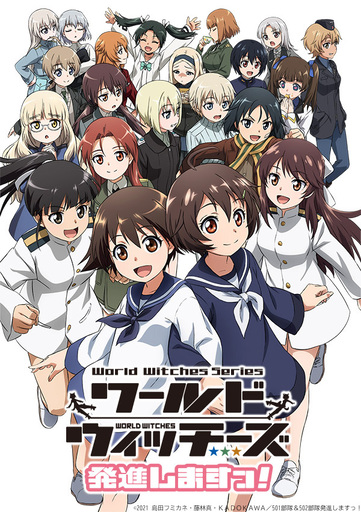
That sure is a lot of witches.
Thankfully, Strike Witches 3 at least avoided some of the even less convincing drama that dragged down parts of the first two seasons. Frankly, I rather enjoy the characters more when they're doing silly things in garrison such as in the Strike Witches: 501 Butai Hasshin Shimasu! (Strike Witches: 501st JOINT FIGHTER WING Take Off!) gag anime. This bodes well for next season's World Witches Hasshin Shimasu! (World Witches Take Off!) installment, although I think I would still prefer it use the standard superlovely character designs than the simpler comedy-friendly ones.
Posted in Strike Witches, Strike Witches: Road to Berlin, World Witches Hasshin Shimasu! | Tags: Air Power, Autumn 2020, Characters in Need of Better Shows, Comedy, Ensemble Cast, Fan Service, Girls With Guns, Light Novels, Mecha Musume, Miyuki Sawashiro, Season Conclusion, Season Introduction, Short Shows, Superlovely Character Designs, Tanaka Rie, THRUST VECTORING, war, Winter 2021 | Permanent Link
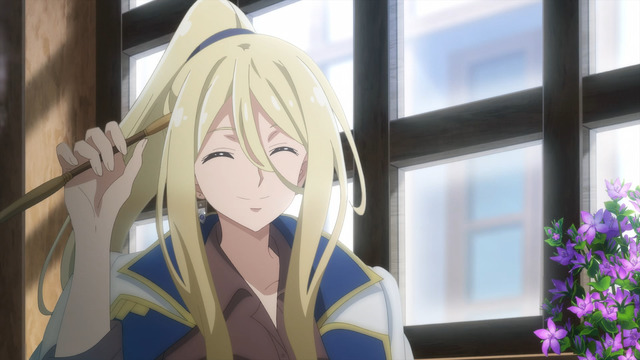
Majo no Tabitabi needed more Sheila.
Majo no Tabitabi (Wandering Witch: The Journey of Elaina) turned out to be a lot different from what I was expecting. I thought it was going to be more laid back, like Flying Witch, but instead the series is more about Elaina observing the fucked-up world around her in a mostly non-committal sort of way. In this respect, I've seen it compared to Kino's Journey (which I haven't seen). I don't know if this is the case for Kino, but Elaina's detachment (and narcissism, honestly) makes her sort of dull, although the strange encounters she has during her travels are interesting.
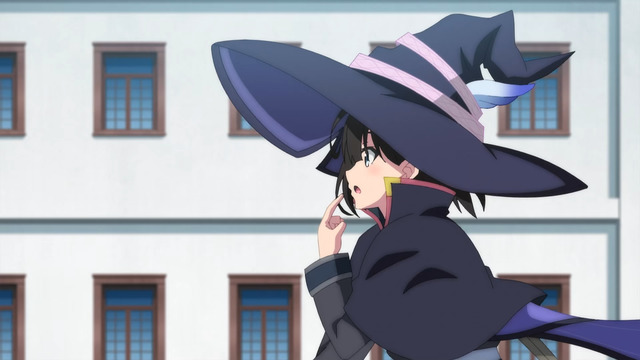
Poor Saya missed out on the final episode's all-you-can-eat buffet.
I'm not suggesting there are major flaws to Wandering Witch that needs improving, but I do think it would be better if Elaina had more charisma. I found myself enjoying Saya's appearances much more than I thought I would, considering she mostly comes across as a turbo-lesbian gag character. Guest appearances by various other witches also helped out the show a lot. The best elements of the show and its finest moments all involve characters other than Elaina. I don't think this is by design, but rather it's because I just didn't find Elaina herself particularly interesting. Ultimately, I did enjoy the show overall, and I would watch more of it, but I'd rather have future episodes told from a different character's point of view if Elaina is going to remain the same.
Posted in Majo no Tabitabi | Tags: Air Power, Autumn 2020, Light Novels, Season Conclusion, Turbo Lesbians, Unrequited Love | Permanent Link
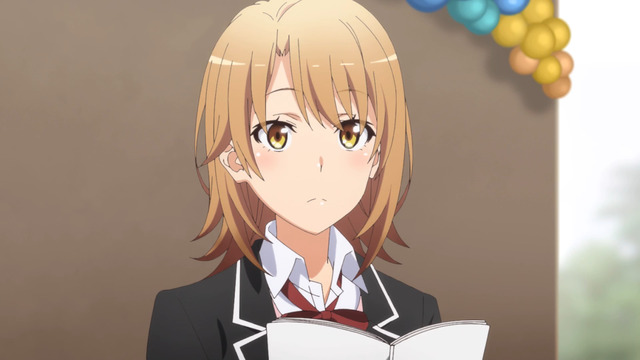
BEST GIRL.
Yahari Ore no Seishun Love Comedy wa Machigatteiru. Kan (My Teen Romantic Comedy SNAFU Climax!, among other localized names) completed the three-season run of a harem comedy that fared surprisingly well despite my initial misgivings. Generally speaking, the term "harem comedy" itself feels anachronistic now and less appropriate even when applied to shows such as Gotoubun no Hanayome (The Quintessential Quintuplets) compared to the label's Love Hina-era association (at least in my mind). I suppose it's probably still applicable for shows such as Kanojo, Okarishimasu (Rent-a-Girlfriend). But I digress.
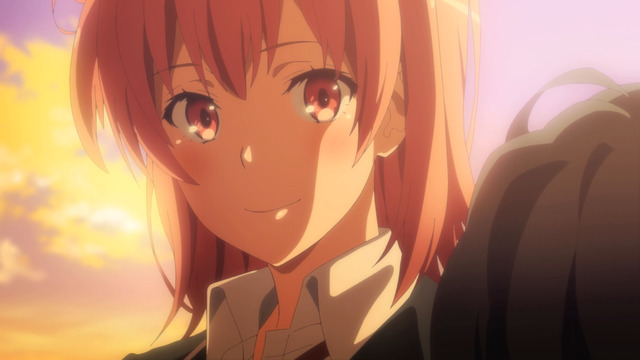
Oregairu might have been a better series if told from Yui's point of view.
These types of shows invoke a competitive element that pits various female protagonists against each other to vie for the male lead's affection, ultimately "winning" by becoming the romantic interest he selects at the conclusion of the series. Longtime readers of this blog may remember I'm not a fan of this construct when the male lead is so frequently a dull sap, to say nothing of the ones who are legitimately terrible cretins. I'm did not watch Kanojo, Okarishimasu, but I did watch it get shredded on the Twitter, and Potato-kun appears to be a colossal douche in addition to the show's numerous other problems. Does the girl who ultimately ends up with such a character really win? [Spoilers: No.]
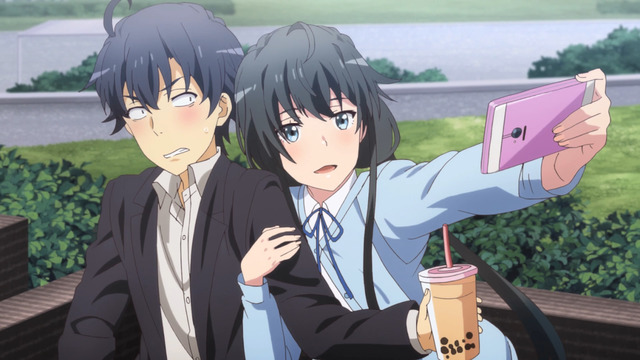
Kids and their selfies.
Oregairu does not suffer from this particular problem, at least by its conclusion. Hachiman in the third season is no longer the same person he was in the first season. Unfortunately, the girl who ultimately "wins" has her own issues. [Spoilers henceforth, obviously, if you haven't already either seen this coming or learned about it via some other way, such as discussions about the light novels' ending.]
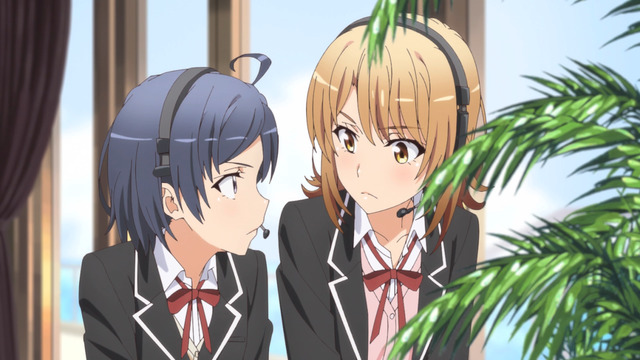
It's about the future, Madam Chancellor.
Yukino is not interesting. She is supposed to be the most complex of the various love interests, and has some significant hang-ups that admittedly align well with Hachiman's character, but I never found her problems or growth compelling. As far as "winning" the harem comedy contest goes, she is the most sensible one to pair with Hachiman, but my lack of investment in their relationship makes the show's resolution somewhat hollow. Ultimately, it was still a good journey, and I can appreciate why Oregairu accumulated so much praise during its run, but I can't quite point to it as a much-watch show by any means.
Posted in BEST GIRL, Yahari Ore no Seishun Love Come wa Machigatteiru, Yahari Ore no Seishun Love Comedy wa Machigatteiru. Kan | Tags: Crying, Douche Bags, First Girl He Sees Clause, Harem Comedy, Light Novels, Love Confessions, Love Hina, Love Triangle, Romance, Season Conclusion, Sequels, Spoilers, Summer 2020, tsundere, Unrequited Love | Permanent Link
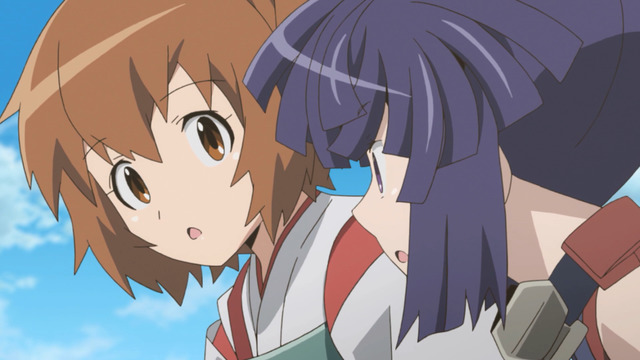
Minori and Akatsuki realize they are rivals.
I finished my re-watch of Log Horizon. It did not go as well as I was expecting. I remembered liking the series more in the past. Objectively, this is still true. I know this because I keep track of my ratings for individual anime episodes on a spreadsheet. (This was originally a joke, but then I kept doing it. See this, for example.) So I can technically quantify numerically specifically how much liked the series more in the past, even though I didn't score the second season very high to begin with. In any case, I liked the series less overall the second time around. That's not doing the upcoming third season any favors. There are two basic problems I have with the anime.
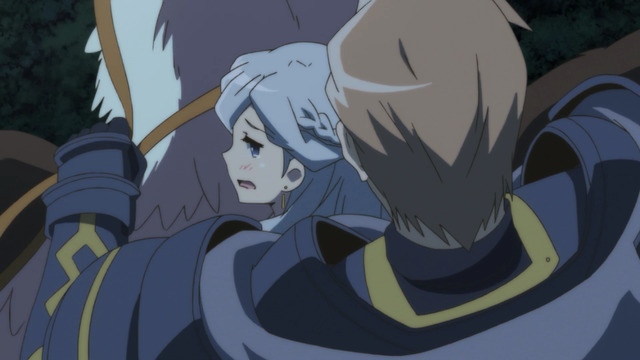
You know you like it.
First, none of the jokes work for me. This includes the recurring gags involving Naotsugu and Akatsuki. There wasn't a reason to repeat them beyond the first episode. Then Tetora shows up in the second season. And fuuuck, Tetora is not amusing. None of those jokes work either. The other problem is the inverse relationship between the characters' reported ages and the maturity levels of their behavior. Well, at least that's the way it seems for the girls.
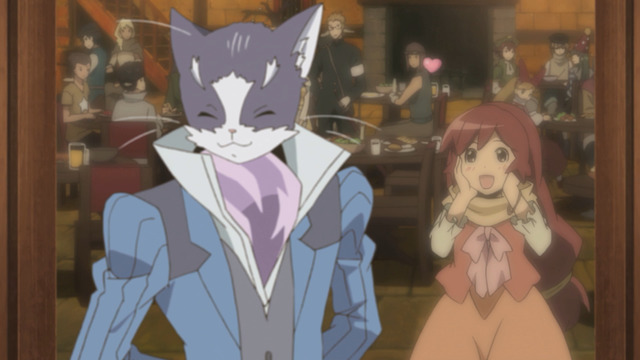
I seriously thought Serara was 12.
The worst offenders are Marielle (28), Henrietta (28), and Serara (16). Marielle is whiny and petulant, constantly throwing literal tantrums about the work she has to do. (She's sort of in charge.) Henrietta is obsessed with molesting Akatsuki and does so at every opportunity. Serara is the nekosexual girl who really, really, really likes Nyanta. All of these characters and their behavior are played for laughs. None of it is funny. On the other hand, Minori is only 14, and the princess who ends up saving her kingdom when the men in charge couldn't get their shit together is only 15. Presumably they'll be older during season three, though. Maybe they'll become less mature in keeping with the rest of the show.
Posted in Log Horizon | Tags: Autumn 2013, Autumn 2014, Comedy, DVDs and Blu-ray discs, Games, Harem Comedy, Light Novels, Moe Blobs, Re-Watching, Season Conclusion, Sequels, tsundere, Unrequited Love, Video Games, war, Winter 2014, Winter 2015 | Permanent Link

I liked the way Sawashiro Miyuki voiced Kitarou.
I knew basically nothing about GeGeGe no Kitarou before I started watching it two years ago. From the promotional material and initial surge of fan art, I at least determined that it was originally a manga from the 1960s that had five previous anime adaptions. It already had hundreds of episodes and numerous updates to its character designs. I decided to give it a chance based solely on this information, even though the NekoMusume character now had legs that went up to her neck. What I found was a modern family show with traditional ties in an anime that frequently featured thoughtful—yet entertaining—episodes.
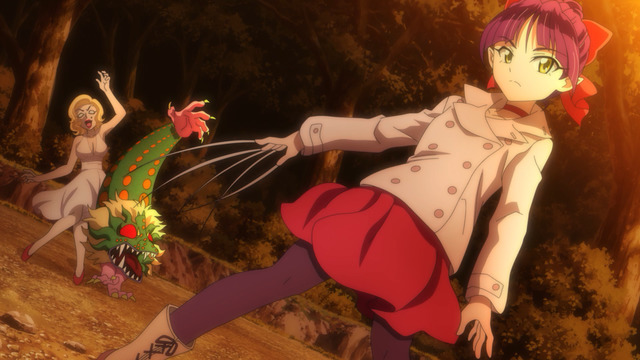
You would not believe how sick NekoMusume is of your shit.
I can't claim the show taught me a lot about yokai and their associated myths, but I'm at least a lot more familiar with them now. This is a sharp contrast to my first encounter with yokai, in Azumanga Daioh. They seemed perplexing and bizarre back then. I suspect this sort of familiarization was also intended for the younger viewers of GeGeGe no Kitarou. I don't know how often yokai feature in children's stories told to contemporary Japanese kids, but watching cartoons about them probably at least reinforces their understanding about old-timey lore. For little kids, it was sort of a violent and grisly show by American standards, though—about on par with what they'd see in Detective Conan.
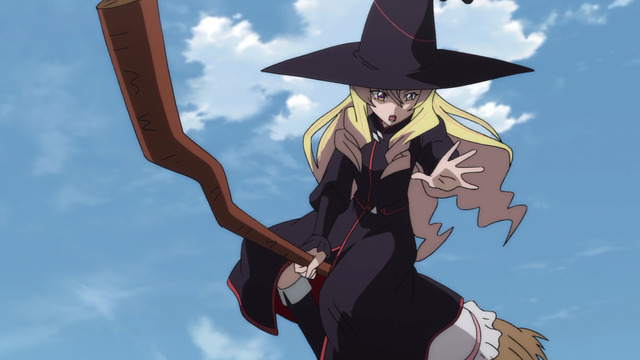
At least the first Backbeard arc gave us Agnes.
P.S. EINS, ZWEI, GUTEN MORGEN.
Ultimately, was it really worth watching 97 episodes of GeGeGe no Kitarou just to say I've seen it? It's not the sort of show I'd recommend for people to plow through if it doesn't immediately capture their attention (to say nothing of the hundreds of episodes that ran prior to the latest iteration), but watching it week-to-week was all right. There wasn't much of a cohesive narrative, discounting some of the longer arcs. Thankfully, the second "Backbeard" arc turned out to be much shorter than the first one, as Backbeard was not much of an antagonist. It turns out the true villains are the evils we bring forth from within ourselves. P.S. Spoilers.
Posted in GeGeGe no Kitarou | Tags: CATS, Legs that go up to her neck, Manga, Miyuki Sawashiro, Season Conclusion, Superlovely Character Designs, tsundere, Unrequited Love, war, War Is All Hell, Winter 2020 | Permanent Link
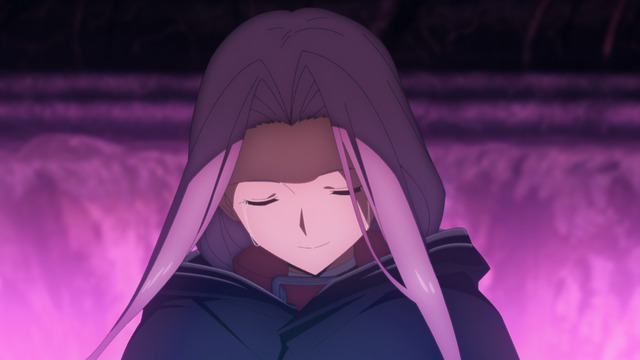
Ana is a good girl.
Firstly, I fully expected to find Fate/Grand Order: Zettai Majuu Sensen Babylonia (Fate/Grand Order: Absolute Demonic Front Babylonia) mostly incomprehensible, since I was basically ignorant about its lore aside from what I managed to glean via the Twitter and from the copious amounts of fan art devoted to the franchise. This did, indeed, turn out to be the case. It certainly does not help that Fate/Baby was episode seven within its underlying Fate GO game's narrative.
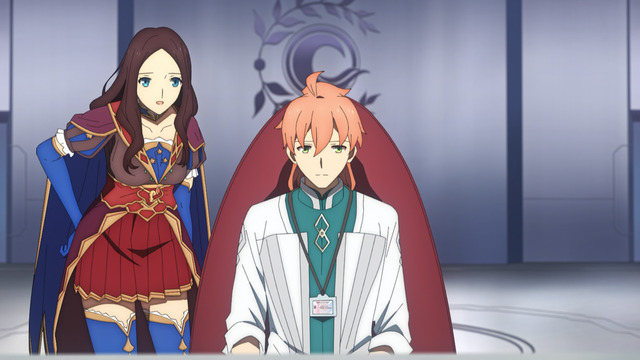
Leonardo never pulled up a chair of her own.
Secondly, none of that mattered, since the animation in Fate/Grand Order: Absolute Demonic Front Babylonia was frickin' amazing. It was literally so good that the story was inconsequential. It's worth watching just because it looks so good. I know in a post-Shirobako world we're not supposed to mention the B-word, but the anime adaptation of a franchise that prints money clearly had resources available to it, that, say, Cop Craft did not. The animation in Cop Craft gave me the impression people were doing the best they could in the face of adversity they did not control. The animation in Babylonia made me think animators were showing off and trying to outdo each other week after week.
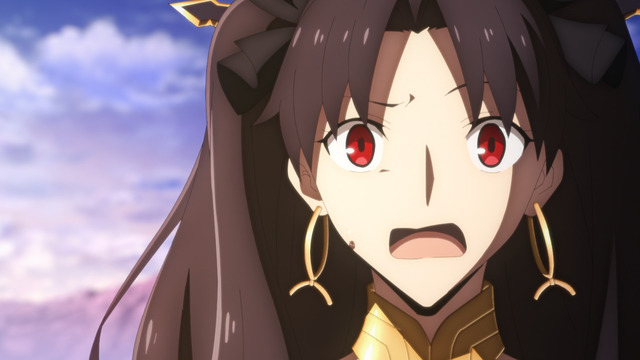
Believe it, baby.
Thirdly, these conditions serendipitously produced the best variant of Tohsaka Rin (Toosaka, whatever) of all time. Even better than Kaleido Ruby. I don't actually know why Ishtar looks like Rin from Fate/stay night. I literally could not break it down for you even though the show explicitly addressed it, and I've read the various summaries found in wikis for the game and whatnot. I find these explanations unsatisfactory. In any event, it doesn't matter. All you need to know is that Ishtar is a game-breaking home run. Oh, and Ereshkigal is okay, too.
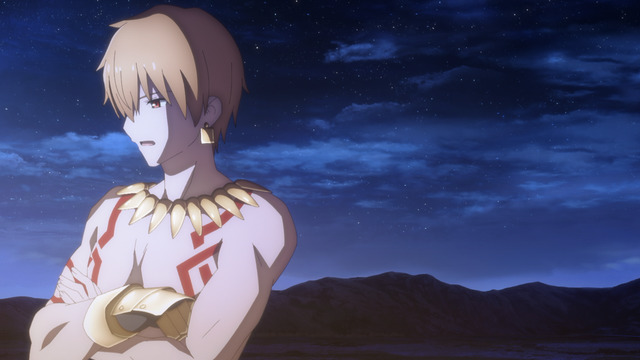
It turns out Gilgamesh was a lot more chill back in the day.
Finally, Fate/Grand Order: Zettai Majuu Sensen Babylonia was a really loud show. I don't think the show streamed with a discrete LFE channel (I didn't check), but it was at least mixed in such a way that every episode got considerable use out of my subwoofer. Planet With was sort of like this too, but it was sort of unpleasant during Planet With. On the other hand the deep impacts and 'splosions in Fate/Baby were really satisfying. I keep telling people not to skimp on the audio portion when setting up their preferred viewing space, whether it be a television or a computer. Hopefully, fans of Babylonia followed this practice as well. Totally worth it.
Posted in Fate/Grand Order: Zettai Majuu Sensen Babylonia | Tags: Air Power, All-Time Babes, Asakawa Yuu, Autumn 2019, AYAKO DOCTRINE, Big Fat Braids, Built for Sin, Fan Service, GAME-BREAKING HOME RUN, Games, Harem Comedy, Legs that go up to her neck, Sakamoto Maaya, Season Conclusion, Superlovely Character Designs, tsundere, TYPE-MOON, Ueda Kana, Video Games, war, War Is All Hell, Winter 2020 | Permanent Link
|
|








